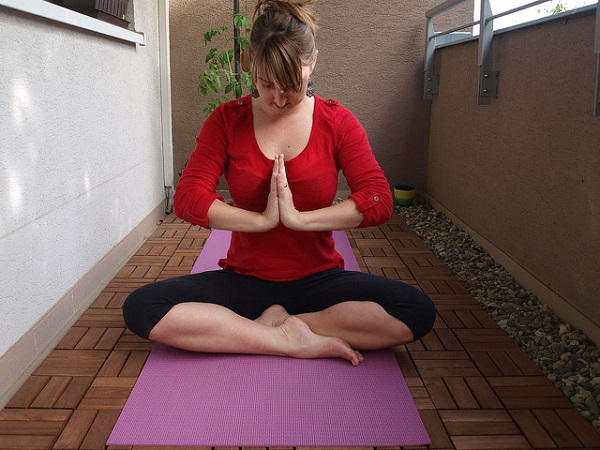
“Half-hearted service is no service at all. Give your whole heart, mind and soul when you serve. This is very important when you practice Karma Yoga.” ~ Swami Sivananda
~
Walk into any yoga studio or look at any studio social media page, and there will be announcements for Karma yoga classes.
These classes benefit a myriad of charities—from animal rescue, to recovery, to homeless charities—and are often donation-based.
While holding donation-based classes for underserved groups and charities certainly falls under the Karma yoga umbrella, there is much more to the practice than most people are cognizant of. A deeper exploration of Karma yoga reveals that it is actually a committed lifestyle rather than a once-a-week or once-a-month endeavor to raise awareness or funding for a cause.
Swami Sivananda identified four paths of yoga: Karma, Bhakti, Raja, and Jnana. For the practicing yogi, one of these paths will emerge as his dominant one, but all are interconnected and work together as he embarks on his yoga journey.
Karma yoga is defined as the “yoga of action” and is the main path taken by those of an outgoing or extroverted nature. The yoga of selfless service, Karma yoga is performed without attachment to outcome. In other words, the Karma yogi expects nothing in return for his service to others. This nothing includes the absence of financial compensation or other material rewards and even the absence of intrinsic rewards. Karma yoga opens our heart and dissolves the ego, so that we can serve not only the needy and underserved, but everyone, because they are all a reflection of ourselves. Just because Karma yoga isn’t a yogi’s dominant path does not mean that she should not incorporate its practice into her life.
A common misconception is that Karma yoga must relate to a yoga class, hence the incorporation of donation-based classes in studios everywhere; however, there are many ways to practice Karma yoga without ever teaching or participating in one of these classes. In truth and ideally, Karma yoga is something the yogi practices daily and is mindful of in each waking moment. How can we be more mindful and deliberate in practicing Karma yoga?
Examine the action’s intention and the yogi’s response.
The foundation of Karma yoga is built on one’s intention for his actions and choices. Is the intention to gain material wealth or to receive recognition or an award? Even expectation that would inflate the ego in the smallest way is a disqualifier.
Each year, Yoga Journal nominates service yogis for the Good Karma Awards. Does this recognition disqualify them from being a Karma yogi? In this case, the answer becomes far more personal. How does the yogi react to this recognition? If the result is an inflated ego, then perhaps their efforts do not qualify as Karma yoga.
Some Karma yogis will forgo fundraising to support their efforts because they see that as a reward of sorts. I believe it is all a matter of interpretation and ultimately dependent upon how the yogi responds to external matters beyond his control. For some Karma yogis, their work is not possible without some funding, and recognition helps spread awareness of the cause and attract donors. In the end, whether something qualifies as Karma yoga is dependent upon the yogi’s intention and reaction. It is not for others to judge.
Karma yoga is judgment-free and non-hypocritical (or as close as possible).
As humans, it is natural that we create judgments about almost all we perceive. However, as Karma yogis, we must be mindful of our judgments and let them go if we are to serve others to the best of our ability. As a prison yoga teacher, I interact with men and women who have committed some serious and sometimes unbelievable crimes; however, when I walk into a prison to teach, all are welcome.
I don’t treat a child molester any differently than someone serving time for a drug charge. This may be hard for most of us to digest because we are emotional and empathetic creatures, especially if a particular crime affects us very personally. Political and religious judgments and ethnic, racial, gender, and socioeconomic stereotyping should be avoided.
Ma Jaya taught to see others as their child-selves—who they were before life took away their innocence. If we seek to see others as children, we are less likely to judge. Perhaps one of the most important practices is that of non-hypocrisy. Serving others is central to Karma yoga, but how can we serve others if we are engaging in the exact same behaviors we are seeking to eradicate? Karma yoga requires us to practice deep levels of svadhyaya, to examine our own motives and judgments, and find our personal truth.
Karma yoga is more than just a Karma yoga class.
Because the practice of Karma yoga is ongoing, we must be aware of how we can serve others every moment of the day.
Yoga is more than asana, pranayama, and the inner contemplative limbs. It involves all eight limbs of yoga, including the yamas and the niyamas. Environmental activism, for instance, is an act of Karma yoga. Standing up for the rights of marginalized populations and the injustices of the world in a peaceful manner all reflect this yogic path. Being mindful of keeping a clean space and body, being kind to others (even when they may not be so kind to us), and being truthful are all Karma yoga practices. Essentially, as we travel through our day, we should be mindful of ways to serve at all times. Helping the elderly with her groceries, rescuing a stray cat, and even washing dishes should all be performed with mindfulness, great care, and the right intention—and are Karma yoga practices.
Always give 100 percent.
Choosing to engage in a Karma yoga practice means always giving 100 percent. That means that even if a yogi has a bad day, he shows up and does the work with the right attitude. Half-hearted effort negates the effects of the Karma yoga. A positive attitude is imperative and can even help the yogi’s perception of his current circumstances improve.
Sometimes, the best therapy for oneself is giving time and service to others. If the yogi is going through a particularly trying time and unable to give 100 percent, he should take some time off and find someone to fill in for him until he is able to perform the service with fervor and a positive attitude. After all, we are human, and self-care is necessary when we are serving others—and sometimes, self-care is a practice of Karma yoga itself. Take a day off, drink some herbal tea, get a massage, take a yoga class, or go for a walk in nature. Being kind to yourself will lead to being kind to others.
Karma yoga will lead to a better understanding of the other three paths.
Karma yoga practices do not live in a vacuum and are closely interconnected to the other three paths: Bhakti, Raja, and Jnana.
Once the Karma yogi’s ego begins to dissolve through selfless service, the practice of Bhakti will open the heart, the Raja path will remove obstacles for the mind and enhance the meditative limbs, bringing more sattva, and the Jnanic yogi in all of us will begin to find connections among the yogic texts to the work that we are doing for others. Karma yoga leads to a better understanding of the other paths and provides a bridge to incorporation and synthesis of them all, regardless of our dominant path.
So participate in that Karma class. Teach a Karma class. And if participation isn’t possible, donating money is a nice substitute; however, begin look at other ways to expand your Karma practice beyond the studio and bank account.
Just imagine if we all practiced selfless service every moment of the day. What a wonderful start to a better world.
~
Author: Angela Still
Image: Sonia Belviso/Flickr
Editor: Catherine Monkman
Copy Editor: Callie Rushton
Social Editor: Callie Rushton











Read 9 comments and reply